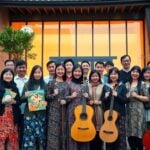Deadline: 1 July 2025
The Science, Technology and Innovation Funding Authority and the Chinese Ministry of Science and Technology has announced the Eighth joint call for proposals in the frame of the Chinese-Egyptian Research Fund (CERF).
With the aim of promoting bilateral research cooperation between the two countries in areas of mutual interest, grants are to be provided to give researchers – including young scientists – an opportunity to address new areas of scientific research.
This announcement is based on the Memorandum of Understanding for the Establishment of a Co-funding Program in Science and Technology between the MHESR and the MOST signed on March 27th, 2016. Funding will be awarded in accordance with the respective national project funding regulations applicable in Egypt and China.
Research Areas
- For Joint Research Project:
- Water
- Food and Agriculture
- Health
- Information and Communication Technology
- Advanced
- Manufacturing for Flagship project:
- Renewable Energy
- Artificial Intelligence
Funding Information
- A maximum grant of EGP 3,000,000 is awarded to the accepted project to cover all costs required to accomplish the project during its entire period, which can be increased to EGP 5,000,000 upon the presence of an industrial partner.
- The maximum duration of a project is 24 months.
Eligible Costs
- Total travel expenses should not exceed 20% of the total budget of the Egyptian side
- Air tickets: economy class
- Entry visa to China
- Health insurance
- Per diem for scientists/experts: to cover the cost of accommodation, meals and local transportation within China. The amount of the per diem will be decided in accordance with the applicable Egyptian governmental financial rules.
- Salaries (not to exceed 25% of the total budget of the project for the Egyptian side). In all cases, the proposed salaries will be subjected to STDF administrative check to ensure its consistency with the salary scale provided by STDF.
- Organizing bilateral, project-related workshops in Egypt: grants can be provided towards costs/expenses such as the preparation of the workshop, rental of the venue, and the realization of events in the context of the workshop.
- Equipment: Project-related equipment
- Other costs (consumables, etc..).
- Indirect costs
Eligibility Criteria
- On the Egyptian side, the Principal Investigator (PI) must be affiliated to an Egyptian research entity (universities, research centers/institutes, etc.).
- The Egyptian PI, should read carefully and adhere to STDF general conditions and guidelines, IPR rules, code of ethics, …etc,
- The Egyptian team of researchers must include at least one Ph.D. holder.
- The project partners on the Egyptian and Chinese sides must structure their cooperation in the following way:
- One of the Ph.D. holders on each side acts as the Principal Investigator (PI).
- In order to receive funding for the joint project, the Egyptian and Chinese sides are required to sign a cooperation document, indicating the obligations and commitments of each side.
- An important additional asset for research proposals is the participation of young.
Evaluation Criteria
- Alignment with Program Objectives and Priorities: the project’s alignment with the program’s specified program’s goals and priorities.
- Academic Excellence and Scientific Merit.
- PIs’ Role and both team contribution in the project activities: the roles of the Egyptian and Chinese principal investigators, as well as their respective contributions to project activities.
- Project originality, Innovation and Creativity: the project’s degree of originality and novelty, taking into account any new techniques, technologies, or approaches.
- Feasibility and Methodology: the project plan, including objectives, procedures, activities, and timeline, to deliver desired results within the given period.
- Involvement of Junior Scientists and contribution to capacity building.
- Budget allocation and Justification: The proposed budget’s Justification is to ensure that the requested budget is distributed efficiently across project phases to achieve project objectives.
- Social Sustainability and Impact of the project on academia and industry in the short and long term, as well as the sustainability of the collaboration post funding.
- Academia-Industry Collaboration: The clarity and efficacy of academic-industry collaborations, including roles, responsibilities, and communication plans. (In Flagship projects).
- Industry Relevance: the project’s applicability to the demands of the industrial partner, any prospective advantages, and the possibility for technology transfer and commercialization. (In Flagship projects).
Application Requirements
- The proposal must include:
- A cover page, to be signed by the Egyptian and Chinese PIs, signed and stamped by their respective institutions, containing the following: [one page]
- Title of the project
- The name, title, and contact information of the Egyptian and the Chinese PI applicants
- The contracting organizations
- The Research Area of the proposal
- Grant duration
- Total budget
- The following sentence: The Egyptian and Chinese applicants hereby confirm that the Chinese and English versions of the preproposals are identical in content.
- The following sentence: The project idea was not funded or submitted to another agency (national or international), or otherwise declared, and the institution approves the project.
- A cover page, to be signed by the Egyptian and Chinese PIs, signed and stamped by their respective institutions, containing the following: [one page]
- The joint research proposal text should comprise:
- Abstract (English and Arabic)
- Problem Definition
- State-of-the-Art
- Objectives
- Statement of the degree of collaboration and the role of each team member
- Role of the industrial partner (in case of Flagship projects)
- Approach and Methodology
- Project Outcomes and Impact
- Mutual visits
- Joint budget
- Key References
For more information, visit STDF.


























